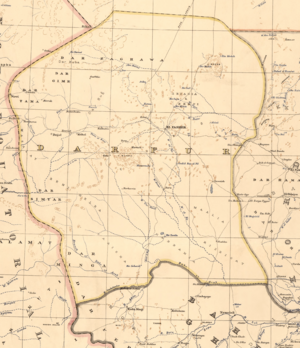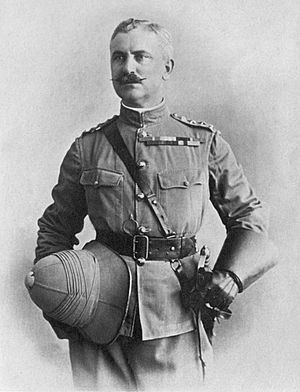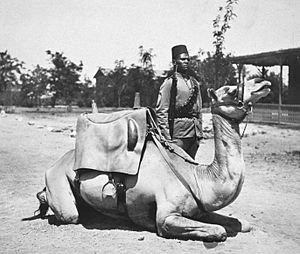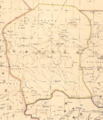Invasion of Darfur facts for kids
The Invasion of Darfur was a military operation where the British Empire and the Sultanate of Egypt took control of the Sultanate of Darfur. This happened between March 16 and November 6, 1916. The ruler of Darfur, Ali Dinar, had been put back in charge by the British after an earlier war. However, during World War I, he started to act against the British. He stopped paying his yearly tribute to the government and showed support for the Ottoman Empire in 1915.
Reginald Wingate, a top British commander, put together a force of about 2,000 soldiers. This force, led by Philip James Vandeleur Kelly, entered Darfur in March 1916. They defeated the Fur Army at a place called Beringia and took over the capital city, al-Fashir, in May. Ali Dinar ran away to the mountains. He tried to talk about surrendering, but the British stopped the talks. When his hiding place was found, a small group of soldiers went after him. The sultan was killed in battle in November 1916. After this, Darfur became a part of the British-controlled Anglo-Egyptian Sudan. It remained part of Sudan when Sudan became independent later on.
Quick facts for kids Invasion of Darfur |
|||||||||
|---|---|---|---|---|---|---|---|---|---|
| Part of the First World War | |||||||||
 Map of Darfur in 1914. |
|||||||||
|
|||||||||
| Belligerents | |||||||||
|
|||||||||
| Commanders and leaders | |||||||||
| Units involved | |||||||||
Elements of
|
Fur Army | ||||||||
| Strength | |||||||||
| 2,000 all ranks |
|
||||||||
| Casualties and losses | |||||||||
|
|
||||||||
Contents
Darfur's History and Location
Darfur, which means "land of the Fur," was an independent country in the late 1800s and early 1900s. It was located west of Sudan and east of what was then French Equatorial Africa. Darfur is about the size of France. It has a dry northern part, a central part with the Jebal Marra volcano, and a southern part with rich soil and lots of rain.
In 1874, Darfur was taken over by its Islamic neighbors to the south. It became part of Egypt and then Turco-Egyptian Sudan. This lasted until the Mahdist War (1881–1899). After this war, the British and Egyptians regained control. In 1899, Ali Dinar became the ruler of Darfur. The British approved this, but he had to pay them a yearly tribute.
Growing Tensions with Ali Dinar
Things stayed calm for a while, but then problems started. There were disagreements about Darfur's western border. The British also thought Ali Dinar's attitude towards them was changing. He would not let any Europeans into Darfur. His rules also caused problems among the Arab people in Darfur, who were often against him. Some tribes, like the Rizeigat, were openly hostile.
When Ali Dinar heard that the British Empire was at war with the Ottoman Empire (Turkey), he became more defiant. In April 1915, he stopped supporting the Anglo-Egyptian Sudan government. He declared himself pro-Turkish and contacted them through the Senussi group. At this time, Darfur had about 1,000,000 people. Ali Dinar had a large army of about 10,000 soldiers.
By December, the situation was so bad that a small group of Egyptian Camel Corps soldiers was sent to protect trade. This was also a warning to Ali Dinar, who was planning to attack the Rizeigat tribe. Ali Dinar responded by moving his own troops to reinforce Jebel el Hella. The British then believed he was preparing to invade Sudan.
The Invasion Begins

To stop the expected invasion of Sudan, Reginald Wingate gathered a force at Nahud. The commander was British Philip James Vandeleur Kelly. His force had about 2,000 soldiers. It included:
- Mounted infantry (soldiers on horseback)
- Camel Corps (soldiers on camels)
- Sudanese and Egyptian infantry battalions
- An Arab Battalion
- Artillery (cannons) and machine guns
Intelligence suggested that Ali Dinar was going to invade Sudan. So, in March 1916, Wingate ordered Kelly to cross the border. Their goal was to take Jebel el Hella and Um Shanga. These two villages had the only permanent water sources on the road to al-Fashir, Ali Dinar's capital.
On March 16, some Camel Corps and mounted infantry scouts crossed into Darfur. Four days later, they took Um Shanga. They met little resistance. However, the water supply at Um Shanga was low. Kelly decided to form a fast-moving group and headed for Jebel el Hella on March 22.
Taking Jebel el Hella
Kelly's fast-moving group met only slight resistance from Fur scouts. About four miles from Jebel el Hella, 800 Fur horsemen tried to surround them. British machine gun fire stopped them. The group then found many Fur troops in a wooded valley. They used artillery and machine guns to scatter them. The column reached Jebel el Hella at 2:15 PM and secured its wells without more fighting.
The main Fur Army was in the capital, al-Fashir. It was estimated to have between 4,000 and 6,000 riflemen. They had old muzzleloader weapons, shotguns, spears, shields, and chain mail. They also had many auxiliary troops armed with spears. Ali Dinar was bringing more troops to the capital.
Dealing with Supply Challenges
Wingate thought Ali Dinar would avoid a big battle and wait for the rainy season. The rain would help the Fur Army with their guerrilla fighting. Kelly's main concern was getting water and supplies for his troops. There had been no rain, and their closest supply point was 300 miles away.
To help with supplies, Wingate started building a road for trucks. This road would go from Rahad to Taweisha and then to al-Fashir, about 460 miles. Once finished, a trip from the rail line to the capital would take four days. The commander of the Egyptian Expeditionary Force also sent four airplanes, cannons, ammunition, wireless radios, and light transport vehicles to help.
Reconnaissance in April
In early April, Anglo-Egyptian patrols found small groups of Fur troops. Kelly ordered a large reconnaissance force to go west to Abiad. Their goals were to find water, scatter any Fur troops, and secure the route between Nahud and al-Fashir. On April 3, the Anglo-Egyptian force reached Burush, forcing out a Fur cavalry unit. The next day, they met 700 Fur men at Um Kedada, but their guns forced them to retreat.
By the end of April, the supply road was secure. Large groups of Anglo-Egyptian troops were stationed along the route. They also set up observation posts along the frontier.
Advance to the Capital in May
In May, the Anglo-Egyptian forces brought forward more supplies to continue their advance. The Fur Army attacked their garrisons at Abiad and a telegraph post. On May 12, a British airplane flew over al-Fashir. It dropped leaflets telling the people that Ali Dinar would be removed and promising religious freedom and justice.
By May 14, Kelly was ready to advance to al-Fashir. He gathered a force at Abiad. Because of water shortages, he divided his force into two columns: a slow-moving one and a more mobile one. They would meet at a point 40 miles west of Abiad, near the village of Meliet, which had a good water supply. Kelly made Meliet his first target.
On May 15, a small group of mounted infantry scouts captured a Fur observation post. The slow-moving column left Abiad that day, followed by the other column the next day. Both columns met on May 17. An airplane bombed about 500 Fur troops at Meliet. The next day, Kelly's columns reached Meliet, which the Fur troops had left. The Anglo-Egyptian force rested there.
The Battle of Beringia
On May 22, the Anglo-Egyptian advance continued. The land had rolling sand-hills and bushes, making it hard to see far. Large groups of Fur camel riders and cavalry were spotted. The Fur Army commander, Ramadan Ali, had dug a crescent-shaped trench, mostly hidden by a dry riverbed. He planned to ambush the Anglo-Egyptians.
The Anglo-Egyptian artillery fired on the Fur trenches, pushing the Fur troops back. Fur horsemen gathered on the left, and the artillery also fired on them. The Anglo-Egyptians formed a square formation and advanced. They started digging their own trenches.
The Anglo-Egyptian forces were about 500 yards from Beringia. The main Fur Army position was 600 yards south of the village. Kelly decided to attack right away. During the attack, some Anglo-Egyptian soldiers entered the village and came under heavy fire. They were forced to retreat, with some Fur troops chasing them. When the Fur troops came close to the Anglo-Egyptian square, the artillery and machine guns opened fire on them.
Seeing this, the rest of the Fur Army left their trenches and attacked the southern side of the square. The Fur attack lasted about forty minutes but failed. The closest they got was about 10 yards from the square. Kelly ordered a counter-attack. The Fur Army broke and retreated, leaving 231 dead and many wounded. Anglo-Egyptian casualties were five dead and eighteen wounded. Kelly continued his advance to al-Fashir.
The Fur Army was not completely defeated. About 500 cavalry and 300 infantry attacked the Anglo-Egyptian camp at 3:00 AM on May 23. Kelly's artillery fired flares, lighting up the area. The attack was defeated. Later that day, several hundred Fur troops appeared on their left side. They were forced to retreat by artillery, machine gun fire, and air attacks. At 10:00 AM, Kelly and his mounted troops entered the capital. They found it empty except for some women. Sultan Ali Dinar had left al-Fashir with 2,000 troops after hearing about the defeat at Beringia. The British captured four cannons, 55,000 rounds of ammunition, and 4,000 rifles in the city.
Pursuit of Ali Dinar
Sultan Ali Dinar fled to the Jebel Marra mountains, about 50 miles southwest of al-Fashir, with about 2,000 men. Kelly's troops could not chase him right away because they lacked supplies and were tired. However, Dinar offered to talk about surrendering. Discussions continued until August 1, when Kelly stopped them. It became clear that Dinar was just trying to gain time.
Dinar's followers started to leave him, and he was left with only about 1,000 men. Kelly's troops had taken Kebkebia, 80 miles west of al-Fashir. A force of 200 men, led by Huddleston, was sent to take Dibbis, 110 miles southwest of al-Fashir. They reached Dibbis on October 13 and defeated a Fur force after a short fight. After this, Dinar again tried to talk about terms. When he seemed to be stalling again, Kelly sent 100 more men to reinforce Huddleston.
Huddleston found out that Dinar was hiding at Kulme, 50 miles to the west. The remaining Fur troops were in poor condition, hungry, and sick. Huddleston marched on Kulme without waiting for more troops. He took the village almost without a fight on November 3. They captured hundreds of prisoners and most of Dinar's remaining military supplies. Some of his family also surrendered.
Dinar fled to Jebel Juba, southwest of Kulme. Two days later, on November 5, Huddleston, with 150 men, an artillery piece, and four machine guns, set off in pursuit. Huddleston reached Dinar's camp on November 6 and opened fire. The Fur troops fled. Huddleston's troops found Dinar's body, shot in the head.
What Happened Next
On November 1, 1917, Darfur became part of Sudan. The cost of the invasion, £500,000, was sent to the Egyptian Government to be paid by Egyptian taxpayers. The British commanders were also recognized. In 1917, Wingate became the British High Commissioner for Egypt. Kelly, the commander of the Anglo-Egyptian expedition, became the first Governor of the Darfur province. He was later promoted and given command of a cavalry brigade fighting in Palestine.
See also
- War in Darfur, a more recent conflict in the region (2003–present)
Images for kids




